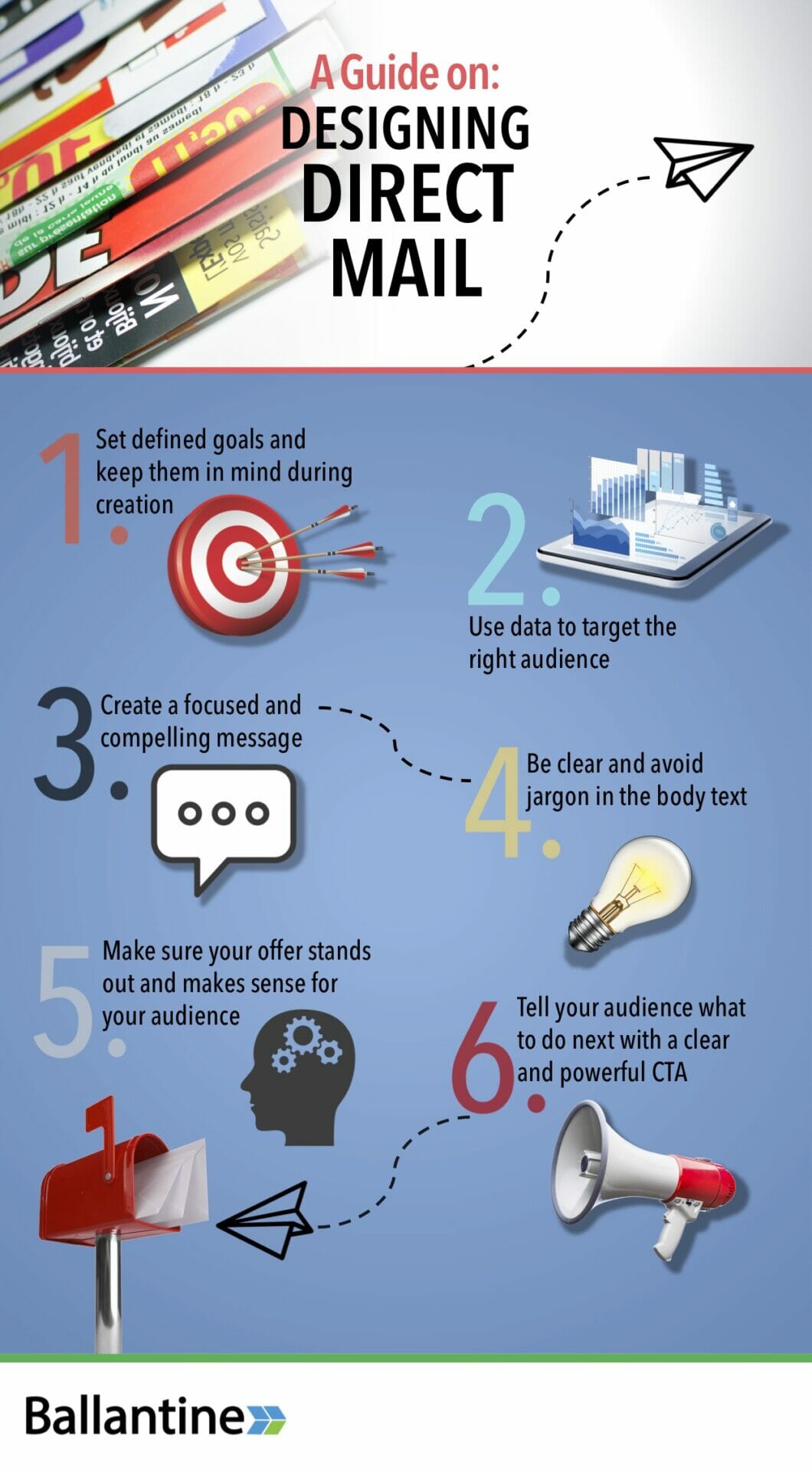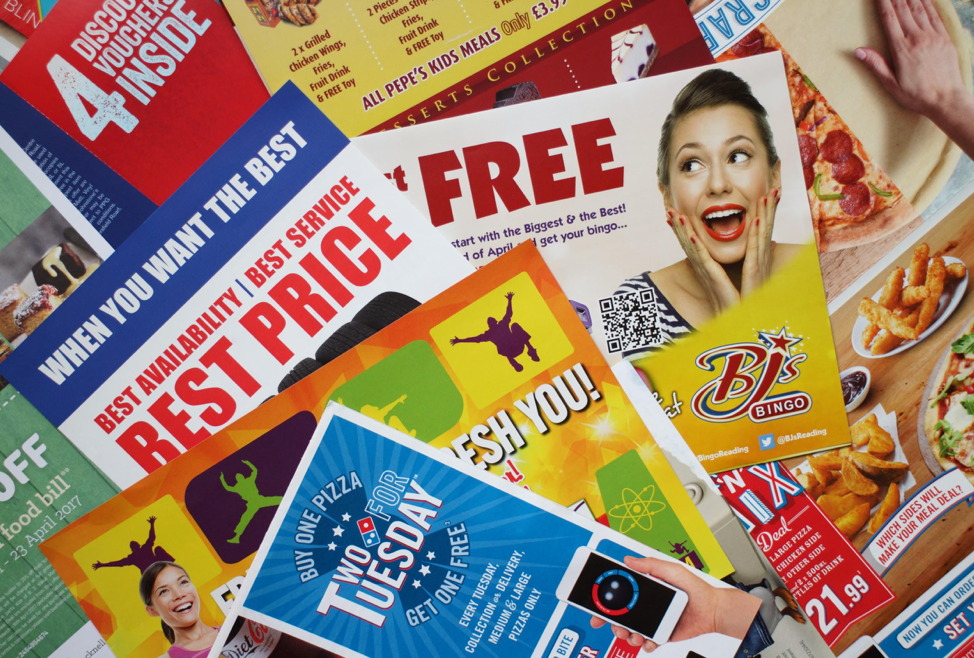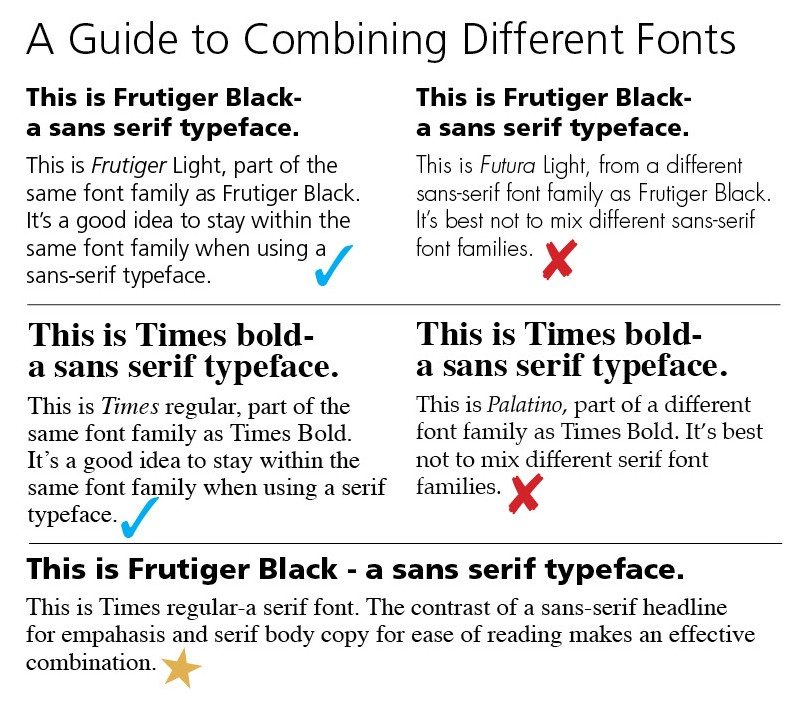Direct mail and print marketing are extremely effective marketing tools for a variety of different businesses and business models. But, designing direct mail pieces must be done by a team of seasoned experts in order to fully take advantage of the effectiveness of direct mail marketing, and have a powerful direct mail campaign . 
Direct Mail Is Not Dead
Before getting into the nitty-gritty of direct mail marketing designs, let’s take a look at why direct mail is such a valuable marketing tool in today’s world. While the perception may be that it‘s influence would be waning in the digital 21st century, it is precisely because of the proliferation of digital marketing that direct mail is so powerful. This familiar marketing platform has reliably seen both a much higher rate of response and a continued sense of trust in consumers. A 2017 Forbes Magazine article cites a Direct Marketing Association’s study that found a 4.4% response rate for direct mail in comparison to 0.12% for email. And from that same article, we find that a study conducted in the UK found that 57% of respondents felt that postcard mailings created a more authentic relationship and made them feel valued. It is perhaps this emotional attribute attached to direct marketing that makes it most valuable. This is especially true when applying this emotional connection with one of the most important demographic markets: Millennials. But at the end of the day, the numbers speak for themselves: direct mailings are an important part of creating a company’s most effective marketing campaigns.

7 Key Considerations For Designing Direct Mail Pieces
Goals, strategy, audience, budget, and copy are all important elements of creating direct mail pieces, but for this post, we’ll focus mainly on design. We’ll touch on these additional elements briefly, as they relate to design.
1. Set Your Goals and Strategy
If you’re doing a direct mail piece, you’ve selected that tactic as part of a strategy to reach a goal. It’s important to keep these goals in mind when creating the piece, to ensure it fulfills its purpose.
For example, if you’re sending out a postcard to all new homeowners in a particular neighborhood to tell them about your veterinary practice with the goal of increasing your client base by 30%, this goal will help you decide how to design the piece.
2. Use Data To Target The Right Audience
Use data to target the right audience. This goes back to your goals and strategy. In the example above, you might purchase a list from a broker to reach new homeowners within a certain distance from your practice.
Understand who is in your audience – what are the demographics of the new homeowners? This information may influence your design.
3. Calculate A Budget
Talk to your printer and mailing house when planning your campaign for production suggestions.
• size
• printing specifications
• fulfillment and mailing specs
• postage
Once you have determined your target audience and defined your production parameters, you can go to your designer armed with the specific information necessary to design your piece. This way you won’t be wasting your time and money going in unnecessary directions. 
Whether you are sending out direct mail postcards or planning a major triggered direct mail campaign using automation, the goal is usually to attract qualified leads. You may be looking for some clever direct mail marketing tips that will make sure your mailings stand out among other campaigns that enter the mailbox with yours. If you find yourself wondering how your direct mail piece can stand out in a crowded mailbox, Ballantine can help.
4. Create A Focused Message And Headline
Cut through the clutter with a focused and compelling message and headline. According to David Olgilvy, five times as many people read the headline compared to the body copy. It’s important to keep in mind that when you have written your headline, you have spent eighty cents out of your dollar so you’ll need to make it compelling. Be sure to:
- Use a powerful, bold headline that tells your story and puts your offer out there. Keep it short and specific. If you’re mailing in an envelope, put your headline message on the envelope and repeat it in your letter or brochure.
- Use subheads to guide a reader through your text
- Subheads highlight your most important points.
5. Avoid Jargon In Your Body Text
Being clear and avoiding jargon doesn’t necessarily mean talking down to your audience. A veterinarian may know that feline odontoclastic resorptive lesions can impair my cat’s quality of life, but I’d prefer to know that:
FORL is a chronic condition that can cause pain and behavioral changes such as a reluctance to eat. A yearly oral exam is recommended. If you notice a change in your cat’s behavior call for an appointment.
It’s not necessarily shorter, but the message to the consumer is up front and highlights what you want to say.
6. Clearly Make Your Offer
Clarity is key. Make sure it stands out and is compelling. Remember your audience and what you’re selling. Be sure the offer is appropriate and compelling to your target audience.
7. Tell Your Audience What To Do In Your Call to Action
What do you want the recipient of your direct mail piece to do? Make it obvious and easy.
- You want a phone call (make sure your phone number is bold.)
- You want an email (make sure you have a simple contact email address that is easy to read, spell, and remember)
- You want a customer to visit your location (make sure the address is printed clearly, and add a map or image of your location)
- You want a website visit (simplify your URL and be sure that it links to a landing page that supports the message of your campaign.)
Remember, if you don’t tell the consumer what to do next; they probably will not do it. Make all of your CTA’s clear while telling them exactly what to do (example: Call us now to save big).
Other Things To Consider:
Visual Design
Branding, branding, branding.
A brand is much more than just a logo. It involves your online experience, your retail or workplace environment, the tone of your copy; and everything that relates to your businesses “personality”.
In terms of your direct mail, use your logo consistently on every component you create. When your customers bring your coupon into the store, make sure they see the logo that’s on the coupon on the store signage.
Keep the tone of your text consistent with your other communications. It’s all part of your brand – it all represents you!
The visual components of your design provide the initial impact of your mailing. Typography, your color scheme, and use of white space and images all contribute to making your piece the one your prospects respond to.
Typography
Ever since we’ve been designing on the desktop, we’ve had the option to use a myriad of fonts on everything we do. Bad idea.
Pick a small combination of fonts – no more than three – that support your marketing and brand then stick to them. You might want to use a strong sans-serif font like the Helvetica or Frutiger families for your headlines and a softer serif font like Times, Goudy or Palatino for your body text. It’s best not to mix two sans serif faces or two serif faces on one piece. Go for the contrast between sans serif and serif.
Colors
Pick a color scheme that makes sense to your audience. Reds for a dentist or doctor is probably a no-no. If you’re a lawyer or an accountant, remember that people expect you to look professional, so that day-glo paisley background is out.
Keep it Simple
Be clear and don’t clutter your message up with unnecessary design elements. A beautiful shot of a flower or a piece of furniture is more compelling than 10 tiny images that are so small a reader doesn’t know what they are.
Images
Images for print are different than those we use for online work. If you download images from the Internet, be sure they are of high enough quality to be printed. If you’re not sure, ask your printer to check before you run the job.
Use your space wisely
Remember that an area of white or a block of color can be as important as an area with text and an image. The goal isn’t to fill up space; the goal is to use it to get your message out.
Make your piece appropriate to your audience and your goal. Many times you might like to use something with all of the bells and whistles you can buy and forget that what really sells is the mix of the right product, the right message and the right creative. With that combination, anything from a postcard to a large scale triggered mail campaign can get you the results you want.
Takeaways
We’ve gone over why direct mail marketing is so important in today’s marketing world, but to use it effectively you must employ the best direct mail marketing designs. By backing up excellent design with a well-planned campaign that is integrated with any digital marketing, a company can achieve results that are unheard of for digital alone. We took a look at some of the most important visual elements of direct mail marketing designs, including:
-
- Branding
-
- Typography
-
- Simplicity
-
- Colors
-
- Images
- Overall Visual Elements
And discussed direct mail design tips for each category. We also explored how the design of the content and text also forms a vital component of creating the best direct mail campaigns. This includes:
-
- Creating a Specific Message
-
- Choosing the Right Headline
-
- Structuring the Body of the Mailing
-
- Including a Clear Offer
- Having an Effective Call to Action
One important part of designing an effective direct mail campaign is making use of the best technology, both to track the effectiveness of the campaign as well as to customize mailings to create a more effective campaign. While the world of digital marketing has created previously undreamed of opportunities to specifically target certain audiences that may be a good fit for a company, look for opportunities to translate that digital data into a direct mail campaign. One way to do this is to actually integrate a digital and direct mail campaign into one. Whether you want to explore some of these integrated options or want to keep direct mail campaigns separate from digital campaigns, your company’s goals and strategy are working together on both the digital and print fronts is important. Effectively integrating digital and print strategy is the future of marketing. By choosing a marketing company that was founded on both digital and direct marketing design, you’re choosing the marketing that is most effective in today’s world. To find out more about how the experts at Ballantine seamlessly blend digital and direct marketing, give us a call at (973) 305-1500 and we’ll discuss the best direct mail ideas and provide the most appropriate direct mail design examples for your business.
*The blog post below was originally written in December 2013 and has since been updated*
In a recent study, 50% of consumers reported that they pay more attention to direct mail than email, and online communications are less trustworthy than “snail mail”.
So with this built-in direct mail (DM) trust factor, it seems logical to maximize the quality of the DM we are producing so that we separate ourselves from the “noise” we sometimes find in our mailboxes.
How can my direct mail piece stand out in a crowded mailbox?
The Message
Cut through the clutter with a focused and compelling message:
Your Headline
“On the average, five times as many people read the headline as read the body copy. When you have written your headline, you have spent eighty cents out of your dollar.” – David Olgilvy
• Use a powerful, bold headline that tells your story and puts your offer out there. Keep it short and specific. If you’re mailing in an envelope, put your headline message on the envelope and repeat it in your letter or brochure.
• Use subheads to guide a reader through your text
• Subheads highlight your most important points.
Body Text
Being clear and avoiding jargon doesn’t necessarily mean talking down to your audience. A veterinarian may know that feline odontoclastic resorptive lesions can impair my cat’s quality of life, but I’d prefer to know that:
FORL is a chronic condition that can cause pain and behavioral changes such as a reluctance to eat. A yearly oral exam is recommended. If you notice a change in your cat’s behavior call for an appointment.
It’s not necessarily shorter, but the message to the consumer is up front and the bullet point highlights what you want to say.
Your Offer
Clarity is key. Make sure it stands out and is compelling. Remember your audience and what you’re selling. Be sure the offer is appropriate and compelling to your target audience.
Call to Action
What do you want the recipient of your direct mail piece to do? Make it obvious and easy.
• Call you (phone number in bold.)
• Email you (email address that is easy to read)
• Visit your location (clear street address, and maybe a map or image of your location)
• Visit your website (big bold URL that links to a landing page.)
Remember, if you don’t tell them what to do next; they might not respond.
Tricks of the Direct Mail Trade
Take advantage of technology that allows you to customize mailings and track data.
• variable data printing to customize and personalize your mailing
• QR code linking to a PURL or landing page.
Your online efforts should support your DM efforts and vice versa. The object is to use all of the tools available to create an integrated campaign.
Design
Your brand, your brand, your brand
A brand is much more than just a logo. It involves your online experience, your retail or workplace environment, the tone of your copy; everything that relates to your business “personality”.
In terms of your direct mail, use your logo consistently on every component you create. When your customers bring your coupon into the store, make sure they see the logo that’s on the coupon on the store signage.
Keep the tone of your text consistent with your other communications. It’s all part of your brand – it all represents you!
The visual components of your design provide the initial impact of your mailing. Typography, your color scheme and use of white space and images all contribute to making your piece the one your prospects respond to.
Typography
Ever since we’ve been designing on the desktop, we’ve had the option to use a myriad of fonts on everything we do. Bad idea.
Pick a small combination of fonts – no more than three – that support your marketing and brand and stick to them. You might want to use a strong sans-serif font like the Helvetica or Frutiger families for your headlines and a softer serif font like Times, Goudy or Palatino for your body text. It’s best not to mix two sans serif faces or two serif faces on one piece. Go for the contrast between sans serif and serif.

Colors
Pick a color scheme that makes sense to your audience. Reds for a dentist or doctor is probably a no-no. If you’re a lawyer or an accountant, remember that people expect you to look professional, so that day-glo paisley background is out.
Keep it simple
Be clear and don’t clutter your message up with unnecessary design elements. A beautiful shot of a flower or a piece of furniture is as compelling as 10 tiny images that are so small a reader doesn’t know what they are.
Images
Images for print are different than those we use for online work. If you download images from the Internet, be sure they are of high enough quality to be printed. If you’re not sure ask you’re printer to check before you run the job.
Find out if the images have any copyright restrictions on them. Check with the owner to see if they want a credit line in exchange for using the image on your mailing or if the image is for sale.
Use your space wisely
Remember that an area of white or a block of color can be as important as an area with text and an image. The goal isn’t to fill up the space; the goal is to use it to get your message out.
Make your piece appropriate to your audience and your goal. Many times you might like to use something with all of the bells and whistles you can buy and forget that what really sells is the mix of the right product, the right message and the right creative. With that combination, anything from a postcard to a 64 – page catalog can get you the results you want from your DM campaign.
Jay Moldave is the President of MoldaveDesigns, a marketing and design firm that has developed communications programs for small businesses, non-profits and major international corporations for over 30 years.
I'm the Director of Digital Services and Partner at Ballantine, a family-owned and operated direct mail & digital marketing company based in New Jersey. and started in 1966 by my great uncle!


![6 Unique Freebies To Include In Creative Direct Mail Pieces [Infographic] Creative Direct Mail Pieces](https://www.ballantine.com/wp-content/uploads/2018/10/6-Creative-Freebies-to-Include-in-Direct-Mail-Pieces.png)

